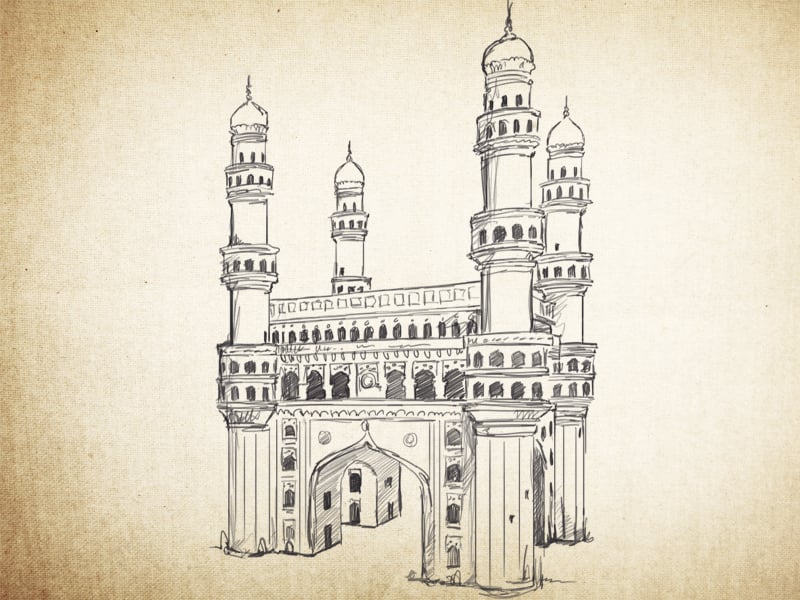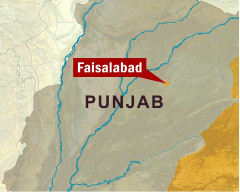
Zubeida Bibi is one of the many Hyderabadis who migrated to Pakistan after Partition and is determined to keep the ways of her ancestors alive through these small rituals. Her community, which is largely defined by its food, language and mannerisms, is one of the many formerly migrant groups that make Karachi a subcontinent in itself.
History
The Hyderabadis who came to Pakistan come from the Deccan region of India. Tracing their footsteps in history, we learn that the area was ruled by the Bahmani Sultanate in 1347. The empire was the first Muslim kingdom in the southern part of India and was founded by Alauddin Hassan, an Afghan by birth and a descendant of Persian King Bahman. How he landed in India is not clear, however, what is known is that he established the Bahmani Empire in the area after revolting against the Delhi Sultanate that ruled the Indian subcontinent at the time.

When the Bahmani Empire started to deteriorate in the 16th century, Sultan Quli Qutbul Mulk, who served the then-Bahmani sultan, conquered the empire’s main city of Golkonda and declared independence from the Bahmani Sultanate. Quli, who migrated to India from a federation consisting of present-day Azerbaijan, Armenia, Iraq and parts of Iran and Turkey, established the Qutb Shahi dynasty in Golkonda in 1518.
Muhammad Quli Qutb Shah, the fifth ruler of the Qutb Shahi dynasty, founded the city of Hyderabad in 1591. The city derives its name from Hyder, the title of the fourth caliph of Islam Hazrat Ali (RA), which means lion. Another myth states that the city was named after the founder’s wife Bhagamati who was named Hyder Mahal after she converted to Islam, while another version claims it was named after his son.
The Qutb Shah Dynasty ruled Golkonda for 171 years but was forced to acknowledge the Mughal Empire’s authority in the later years. In 1687, the area was taken over by Mughal emperor Aurangzeb and was made a province of the empire.

In 1724, Nizamul Mulk Qamaruddin, a Mughal viceroy, declared independence from the Mughal Empire and established the Asif Jahi Dynasty. During the rule of this dynasty which lasted for two centuries, Hyderabad became a prominent Muslim state and a stronghold of Islamic identity in the Indian sub-continent which was greatly influenced by colonial culture.
When the British colonial forces arrived in India and strengthened their grip on the subcontinent, the Asif Jahi ruler signed an alliance with the British East India Company. In 1798, Asif Jahi dynasty’s capital, Hyderabad, became a princely state under the Company’s governance.
And then Partition happened. The princely states present were given a choice between joining Pakistan, India or staying independent. Hyderabad decided against joining the Indian Union and opted to stay sovereign, surrounded by Indian states. However, the independence didn’t last very long and the Indian army forcibly took over in 1948. The majority of the people who migrated from Indian Hyderabad arrived in Karachi and settled mainly in Hyderabad Colony, Laiqabad and Bahadurabad.

(This historical account has been compiled from the following sources: Locating Home: India’s Hyderabadis Abroad, Our faithful ally, the Nizam, The Indian Empire: Its People, History and Products, Golconda Through Time: A Mirror of the Evolving Deccan, Hyderabad State and the Greater Hyderabad Municipal Corporation website)
Whet your appetite
More than anything, the Hyderabadi community is known for its mouth-watering cuisine, which is a unique blend of Mughlai, Arabic and Telugu food. Typical to any Indian dish, the Hyderabadi food is a blend of aromatic spices and herbs, the most prominent ingredients being coconut, tamarind, peanuts and sesame seeds.
According to Henna Khan, a Hyderabadi mother, people expect to be served kachi yakhni ki biryani, mirchi ka salan, begharay baigun and khoobani ka meetha when they attend a Hyderabadi get-together.
However, Khan says these are festive dishes associated mainly but not exclusively to important occasions such as weddings or Eid. On an average day, a Hyderabadi kitchen is filled with the aroma of simmering khatti daal, dalcha or tamater ka kut, to be served with kulfa ghost or dum ka qeema.
“We also have a great snack menu with luqmi, special dahi baray and mirchi pakori,” boasts a visibly delighted Khan.
Chakna, however, is the one controversial dish on the Hyderabadi menu, which the older generation cannot get enough of but the younger ones try hard to disown. A spicy stew made out of goat tripe, chakna also contains chunks of liver and kidneys. If you feel daring enough to give it a try, visit Karachi’s Hyderabad Colony and ask anyone to direct you the closest joint selling this chopped-up delicacy.
The whole nine yards: Fabric, style and fashion
With traditions that are as grand as their cuisine, their aesthetics lack no splendour either. Hyderabadi women can be seen carrying elaborate, six- metre long dupattas during wedding ceremonies. Their traditional dress called the kurtanni comprises a twin-layered shirt, churidaar pajama and a long dupatta that is wrapped around the body in a specific style known as khara dupatta. The method of pinning the dupatta around the body is so intricate that only a few women in any family have mastered the art.
Shamin Arif is one of those women in her family. She tries to arrive early to family weddings anticipating frantic girls, carrying their dupatta with a bunch of safety pins, looking for her. While many think it is a complex way of tying a simple dupatta, Arif does it meticulously.

“It’s fairly simple if you get the hang of the method and the sequence,” says Arif.
For men, the attire consists of a plain kurta over a white pajama, while on special occasions they would don simple sherwanis. Today, this is a rare sight with a vast majority sticking to the standard shalwar kameez.
Sui generis traditions
Influenced by various cultures over the years, Hyderabadi traditions are intriguing to say the least. Nazia Ahsan, a Hyderabadi who has lived in both Pakistan and India, shared a few fascinating customs followed by the community. She, however, was quick to mention that these practises vary from family to family.
- The bride is given a special necklace called kali poath (Hyderabadi version of mangalsutra — a sacred Hindu thread given by the groom to the bride) after the wedding ceremony. In the ritual, the mother-in-law puts the necklace around saath suhaguns (seven married women) before she places it around the bride’s neck. Similarly, many wedding-related rituals are performed with the help of married women as it is assumed it brings good luck to the new bride.
- Hyderabadis believe in the concept of Charshamba — Wednesday in Hindi. Important work is avoided on this day of the week, for they believe that anything that happens on Wednesday repeats itself three more times. For instance, if someone dies in a family on this day, it is believed that three more deaths will follow.
- Hyderabadis emphasise manners and etiquettes; the young usually greet elders with an adaab or bowing their head in respect. The elder person reciprocates by gently placing their hand over the head, or sometimes by kissing the forehead. The elders also expect the younger members of the family not to seat themselves at a level higher than theirs.
- Many Hyderabadi families also take great care during their daughter’s first pregnancy. The woman is brought home in the seventh month of her pregnancy following a ceremony called Satwasa, in which she is given seven fruits of the season as a present. On the sixth day after the birth of the baby, the baby is given a name at a ceremony called chatti. Forty days after the birth date, the parents are showered with gifts in yet another gathering called chilla. This also marks the return of the mother to her in-laws’ house.
As the guests leave, Zubeida Bibi takes a deep breath while her stomach growls in protest. Her mind has been so preoccupied with feeding her guests that she has not put a single morsel in her mouth all day. In her books, it is impolite not to give complete attention to your visitors. But before she can savour the biryani and mirchi ka salan, she has one more important task left. Her wide-eyed grandchildren are still waiting for their share of the paan. And she must prepare it with extreme care if the original taste is to be preserved for future generations.

Fact box
• The city of Hyderabad in Pakistan has nothing to do with the Hyderabadi community that migrated from India.
• Famous TV personality, Anwar Maqsood traces his roots to Hyderabad. Professional tennis player Sania Mirza was also brought up in Hyderabad, India.
• After 1947, most of the Hyderabadis initially settled in Karachi’s Hyderabad Colony, Laiqabad and Bahadurabad area.
• ‘Charminar’ (Four towers) — the global icon of Hyderabad, India — was replicated in Pakistan in the form of a roundabout in the Bahadurabad neighborhood of Karachi.
• Hyderabadis never speak in a literal sense; when they say they want something itna sa (just a little), they don’t really mean little. When they say they did something parson (day before yesterday), they mean they did it ages ago.
Ferya Ilyas works with The Express Tribune as a sub-editor. She tweets @ferya_ilyas
Published in The Express Tribune, Sunday Magazine, December 1st, 2013.
COMMENTS (17)
Comments are moderated and generally will be posted if they are on-topic and not abusive.
For more information, please see our Comments FAQ



































1713853507-0/MalalaHilary-(2)1713853507-0-270x192.webp)








I found the brief summary on Hyderabad very intresting and informative. I was born in Hyderabad and has visited it twice after my parents moved to Pakistan. I feel pride in the rich culture, mannersism and food delicacies of Hyderabad.
Abbotabad needs renaming in any case like Motogomery was renamed Sahiwal, Lyalpur was renamed Faisalabad etc. Very good suggestion and strongly supported renaming Osmanabad or Nizamabad. Habib
Burhan's suggestions are most apt. Pakistani needs to recognize's the Nizam's services. It was Mir Osman Ali Khan, the Nizam bulldozed by the Indian invasion, who supported Pakistan when India's thug rulers/warlords stole Pakistan's share.
Nice article. But please note Hyderabad never declared independence from The Moghuls. To the last day The Nizams called themselves Subedar of The Mughals.
That the empire disintegrated Nizams were left with no option but to hold fort and they did do admirably for 250 years when this beautiful culture evolved thanks to good governance, law and order, peace and prosperity. But Hyderabadis should fly the flag high in Pakistan.
They must try to name Abbotabad after the Nizam either Nizamabad or Osmanabad in memory of the great unsung hero of the last century who attracted an invasion on his own state by helping Pakistan in hour of nèed.
Nice article. But please note Hyderabad never declared independence from The Moghuls. To the last day The Nizams called themselves Subedar of The Mughals.
That the empire disintegrated Nizams were left with no option but to hold fort and they did do admirably for 250 years when this beautiful culture evolved thanks to good governance, law and order, peace and prosperity. But Hyderabadis should fly the flag high in Pakistan.
They must try to name Abbotabad after the Nizam either Nizamabad or Osmanabad in memory of the great unsung hero of the last century who attracted an invasion on his own state by helping Pakistan in hour of nèed.
Superb article....overall you describe da complete history of Hyderabad deccan...Appreciate da way u wrote abt History of Hyderabad & its culture ...its been pleasure 2 read abt about my state in your news paper Cheers A reader frm Hyderabad Deccan.
Dear Mr. Khanzada, Thank you for accepting my correction in a gracious manner. I am most grateful to you for your kind comments about my late father..I am currently in the process of translating his last book "Zawal-e-Hyderabad ki ankahi dastaan", from Urdu to English, which is an eye-opener. Best Regards.
Mr. Mahmood Mushtaq Sahib, apologies for the discrepancy and thank you for pointing out the inaccuracy which was unintended in my comments. Undoubtedly you are most qualified to comment on this topic. Let me just say that Mushtaq Ahmad Khan Sahib's contributions to both Hyderabad State and Pakistan were immense and will always be remembered. It is most unfortunate that men of his noble character, patriotism and personal integrity are now virtually extinct in Pakistan!
For KHANZADA, Your above statement is totally false. I am the son of Nawab Mushtaq Ahmed Khan, who came to Pakistan in 1948 as the Agent General of Hyderabad in Pakistan. I know that we have no one in our family by your name. The second false statement you have made is that my father was the Treasurer of the Nizam. He was in fact a senior member of the Nizam State Railways. Please desist from making false statements in the comments.
Khanzada, Could you disclose your full name please! Your comments are totally false, because I happen to be the only son of nawab Mushtaq Ahmed Khan , Agent General for Hyderabad in Pakistan. We have no one by the name of "Khanzada" in our family. Your statement that Mushtaq Ahmed Khan was the Treasurer of the Nizam is false. My father was with the Nizam State Railways at the time of his appointment by the Nizam in 1948 to represent him in Pakistan :
My Grandfather Mushtaq Ahmed Khan was the Treasurer of the Hyderabad State during partition and was an emissary of the Nizam of Hyderabad in the newly formed State of Pakistan after 1947.
Loved the article.. loved the way you have put that into words. I can totally relate to it :D
As a Punjabi who's been to Karachi, I have great admiration for Hyderabadi culture and I think Hyderabadis are like that element in a recipe that makes the dish more flavoured. It's great to see Pakistani culture being so rich with diverse people.